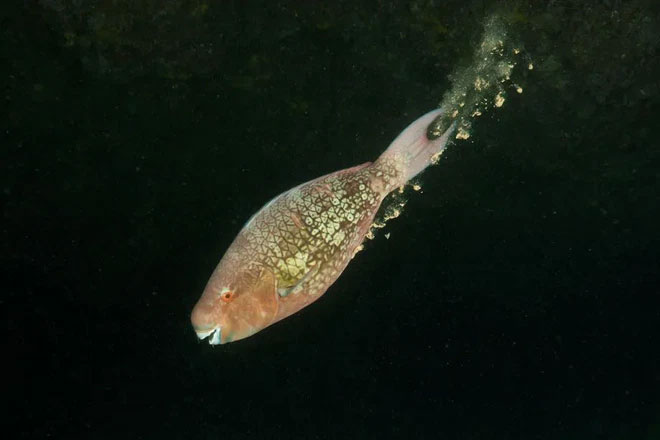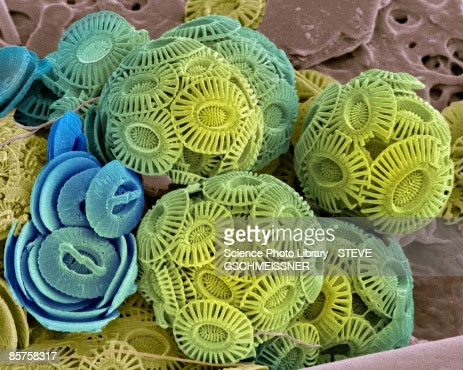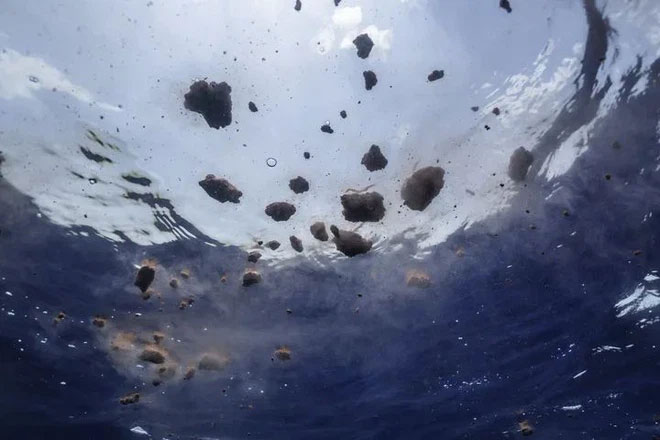According to a new study published in the journal Science Advances, fish and their feces play an extremely important yet undervalued role in ocean chemistry and the carbon cycle that shapes Earth’s climate.
The biodiversity crisis has a message for climate scientists everywhere: Pay more attention to fish feces, said lead researcher Dr. Daniele Bianchi, an expert in Ocean and Atmospheric Science.
Here’s how the story goes: Tiny marine organisms commonly referred to as phytoplankton absorb carbon from the surrounding water and air. When phytoplankton are consumed by larger organisms, carbon moves up the food chain and into fish. Those fish then excrete a significant amount of carbon back into the ocean through their feces, most of which sinks to the ocean floor and can sequester carbon for centuries. The scientific term for carbon storage is sequestration.
“We believe this is one of the most effective carbon absorption mechanisms in the ocean. It reaches deep layers where carbon is isolated for hundreds or even thousands of years,” Vox quoted Daniele.

Fish excreting carbon-rich feces.
Carbon stored in the deep ocean does not contribute to ocean acidification or heat retention in the atmosphere. In other words, fish feces could serve as a bulwark against climate change.
The problem is that commercial fishing has made the global fish population smaller than before. As scientists uncover the importance of fish feces, they also recognize a new danger posed by large-scale fishing. Beyond putting ecosystems at risk, this industry is disrupting major nutrient cycles and potentially eroding an important carbon sink.
How much carbon do fish excrete?
Each year, about a quarter of the carbon dioxide emitted from cars, factories, and farms ends up in the oceans, making the oceans one of the largest carbon sinks in the world. Most of that carbon is absorbed by phytoplankton, which are then eaten by other marine organisms, and subsequently consumed by fish. That’s Food Chain 101.
What Daniele and his co-authors wanted to know was the quantity of phytoplankton, how much carbon in them ends up in the stomachs of fish, and where the carbon from fish goes. The researchers focused on ocean analyses before industrial fishing began in the 19th century and during the “peak fishing” period around the early 20th century. “Peak fishing” led to overfishing of oceans in a way we recognize today, Daniele noted.

Phytoplankton in the ocean.
The research team had reliable data on commercially fished species like tuna and cod, which have been extensively studied by the fishing industry. According to their analysis, before the pre-industrial fishing era, these fish alone consumed about 940 million tons of carbon each year, or 2% of the total biomass produced by phytoplankton.
“Two percent may sound small, but in reality, it’s a very large number,” Daniele said. For comparison, the amount of carbon dioxide emitted by the UK last year was 326 million tons.
The figure of 940 million tons increases to 1.9 billion tons of carbon, or 4% of the total annual phytoplankton biomass, when the authors estimate the impact of all fish species, not just those harvested by the industry.
Meanwhile, during the peak fishing period—when the fish populations in the oceans were about half of what they were before the Industrial Revolution—the amount of carbon consumed by fish populations globally was significantly smaller. Commercially fished species accounted for about 1% of the total phytoplankton biomass, Daniele noted.
What is happening in the oceans today is quite similar: Fish are absorbing biomass and carbon more than one and a half times compared to before, simply because the number of fish is much lower.
Why is fish feces important for Earth?
When fish hold carbon at the bottom of the ocean, the amount of gas left to warm the planet is significantly reduced. This is where feces come into play. About one-fifth of the biomass that fish consume “returns to the environment in the form of fecal pellets,” the authors wrote. These pellets quickly sink into the deep ocean because they are relatively larger and denser than the feces of smaller organisms. This is key for long-term storage.
“When discussing carbon sequestration, a really important metric is the depth of carbon in the ocean. Deeper molecules are isolated for longer periods,” researcher Sasha Kramer (who did not participate in the study) told Vox. According to Dr. Daniele, commercial fish sequester about 10% of carbon in the deep ocean, and the carbon is “trapped” for 600 years or more—meaning fish feces create a significant carbon memory.
According to a recent study in the journal Science Advances, fish can also sequester carbon when they die and sink to the ocean floor. In an interview with Vox, Gaël Mariani, the lead author of this study, noted that a fish contains about 12.5% carbon. That carbon could be trapped in the deep ocean, assuming the fish carcass remains there.
Conversely, when fish are harvested, a portion of the carbon within them is released back into the atmosphere a few days or weeks later. This means that a large fishing operation will emit a substantial amount of carbon that could have been stored had the fishing not occurred. According to the study’s estimates, from 1950 to 2014, fishing fleets harvested about 320 million tons of large fish like sharks and tuna, “preventing” around 22 million tons of carbon from being sequestered.
“We must think about the interaction between fishery management and carbon management. When we manage fisheries and set targets, we should also consider how that will affect the ocean’s carbon storage capability,” Vox quoted University of British Columbia professor William Cheung, a co-author of the aforementioned study on fish feces.
The impact of fish and their feces is not just carbon. For example, fecal pellets provide food for some organisms in the deep sea. When consumed, these organisms use up oxygen, affecting the amount of oxygen available at depths that are already low in oxygen, according to the authors. Climate change may also disrupt the delicate oxygen balance in the deep sea, researcher Sasha noted.

Feces of a blue whale.
Fish are not the only marine organisms that shape ocean chemistry. For instance, a 2010 study found that the feces of baleen whales are very rich in iron, which can help phytoplankton bloom in the Southern Ocean. In turn, this helps reduce carbon.
According to this third study, if the population of baleen whales in the Southern Ocean were restored, it could lead to the population of certain marine organisms in those waters flourishing. “This food chain helps retain more iron in the surface waters, which is beneficial for phytoplankton, thus sustaining productivity,” said the lead author of the study, Stephen Nicol from the University of Tasmania.
Baleen whales (Mysticeti) are a type of whale that filter food from the water using baleen plates instead of teeth, unlike toothed whales (Odontoceti).
The Southern Ocean is the body of water surrounding Antarctica that was officially recognized as the world’s fifth ocean by the National Geographic Society on June 8, 2021.
How does commercial fishing impact ocean chemistry and climate change?
Just as humans have industrialized agriculture with large tractors powered by artificial intelligence (AI) and extensive monocultures, we have also found ways to harvest fish in large quantities using nets, trawls, and large dredging machines. In one year, fishing vessels can catch over 80 million tons of seafood. Today, more than half of the ocean is covered by industrial fishing activities, and as of 2017, one-third of the world’s marine fish stocks have been overfished, according to statistics from the study.
The problems of overfishing extend beyond the harm to important species like sharks, rays, and endangered species such as the vaquita (California porpoise, a species of porpoise that lives only in the northern Gulf of California). Researchers like Daniele are demonstrating that these issues also extend to climate. By contrasting today’s depleted oceans with a theoretically “pristine” ocean, Daniele and his co-author scientists are proving the types of benefits a full ocean provides.
“The authors are hypothesizing that an ocean without fishing would be more resilient to some of the human-induced impacts of climate change,” Sasha said. If the ocean were not overfished, the authors imply that “more of that carbon would be utilized,” which does not account for the carbon that bottom trawlers suck up or the greenhouse gases emitted by shipping vessels. For example, estimates suggest that in 2016, industrial fishing vessels emitted about 159 million tons of CO2, nearly equivalent to the emissions of the Netherlands last year (2020).
It is not easy to end industrial fishing. Seafood provides protein for approximately 3 billion people worldwide and supports around 60 million jobs. As marine biologist Daniel Pauly argues in the controversial Netflix documentary Seaspiracy, completely giving up seafood is also not feasible. “This is a position that only a small portion of the population in wealthier countries will adopt,” Daniele writes.
However, there are many ways the industry can improve, and understanding how the industry impacts the Earth’s climate will be a part of that change. What Danielle hopes others will take away from the research on fish biomass is that fish are essential for the chemical processes of our oceans. “We have altered their biomass,” he concludes, “and that has consequences.”
Dr. Daniele Bianchi, the lead researcher mentioned in this article, is currently an assistant professor in the Department of Oceanic and Atmospheric Sciences at the University of California, Los Angeles (UCLA).


















































